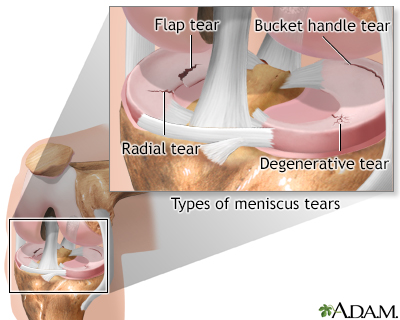Meniscus tears
Knee cartilage tear
The meniscus is a c-shaped piece of cartilage in your knee joint. You have two in each knee. Meniscus cartilage is a tough but flexible tissue that acts as a cushion between the ends of bones in a joint.
Meniscus tears refer to tears in this shock-absorbing cartilage of the knee.
The meniscus forms a cushion between the bones in your knee to protect the joint.
The meniscus:
- Acts like a shock-absorber
- Helps distribute the weight to the cartilage
- Helps to stabilize your knee joint
- Can tear and limit your ability to flex and extend your knee
A meniscus tear can occur if you:
- Twist or over-flex your knee
- Quickly stop moving and change direction while running, landing from a jump, or turning
- Kneel down
- Tear the other ligaments in the knee, like your anterior cruciate ligament (ACL)
- Squat down low and lift something heavy
- Get hit on your knee, such as during a football tackle
As you get older, your meniscus ages too, and it can become easier to injure.

A meniscal tear is an injury of the shock-absorbing cartilage in the knee. The meniscus is a C-shaped fibrous cartilage that is found in certain joints forming a buffer between the bones. The meniscus also serves as a shock-absorption system, assists in lubricating the joint, and limits the joint flexion and extension.
Meniscus injury symptoms
You may feel a “pop” when a meniscus injury occurs. You also may have:
- Knee pain inside the joint, which gets worse with pressure on the joint
- Knee swelling that occurs the next day after injury or after activities
- Knee joint pain when walking
- Locking or catching of your knee
- Difficulty squatting
After examining your knee, the doctor may order these imaging tests:
- X-rays to check for damage to the bones and the presence of arthritis in your knee.
- An MRI of the knee. An MRI machine takes special pictures of the tissues inside your knee. The pictures will show whether these tissues have been stretched or torn.
If you have a meniscus tear, you may need:
- Crutches to walk until the swelling and pain get better
- A brace to support and stabilize your knee
- Physical therapy to help improve joint motion and leg strength
- Surgery to repair or remove the torn meniscus
- To avoid squatting or twisting movements
Treatment may depend on your age, activity level, and where the tear occurs. For mild tears, you may be able to treat the injury with rest and self-care.
For other types of tears, or if you are younger in age, you may need knee arthroscopy (surgery) to repair or trim the meniscus. In this type of surgery, small cuts are made to the knee. A small camera and small surgical tools are inserted to repair the tear.
A meniscus transplant may be needed if the meniscus tear is so severe that all or nearly all of the meniscus cartilage is torn or has to be removed. The new meniscus can help with knee pain and possibly prevent future arthritis.



